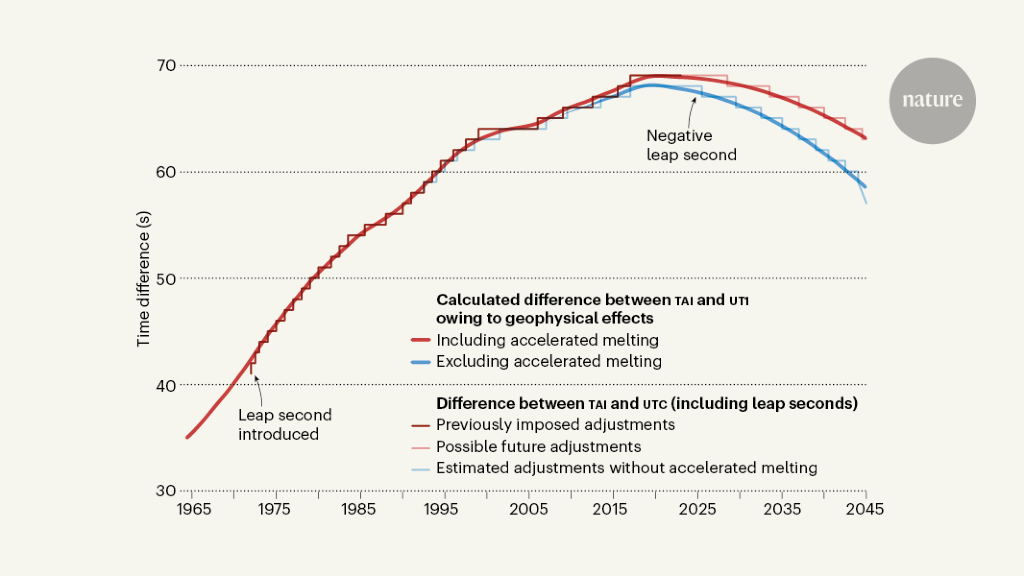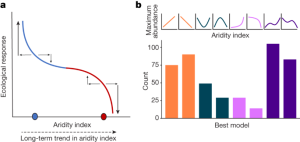
The leap-second problem can be solved by melting ice
Geophysical consequences of the new rule for the measurement of time and of frequency: From an Earth-centered to a rotating, non-uniform rotating body
Agnew thinks that this could happen later than previously thought due to climate change. Data from satellites mapping Earth’s gravity show that since the early 1990s the planet has become less spherical and more flattened, as ice from Greenland and Antarctica has melted and moved mass away from the poles towards the Equator. The planet’s spin is slowed by the flow of water away from Earth’s axis of rotation, just as a spinning ice skater slows down by extending their arms away from their body.
But on shorter timescales, geophysical phenomena make the rotation rate fluctuate, says Agnew. Right now, the rate at which Earth spins is being affected by currents in the liquid core of the planet, which since the 1970s have caused the rotation speed of the outer crust to increase. This has meant that added leap seconds are needed less frequently, and if the trend continues, a leap second will need to be removed from utc.
In 1967, the internationally accepted definition of the second changed. The standard for measuring time was linked to the Earth’s rotation, but now it is decided by a quantum transition between two states of a caesium atom. The change was motivated by the fact that caesium atomic clocks kept time on the basis of ultrastable frequencies. This seemed like a safer bet than Earth’s movements, which weren’t as regular as was first assumed.
Metrologists would be happy with a delayed leap second. Leap seconds are a “big problem” already, because in a society that is increasingly based on precise timing, they lead to major failures in computing systems, says Elizabeth Donley, who heads the time and frequency division at the National Institute of Standards and Technology in Boulder, Colorado.
The maximum difference will be increased in or before the year 2035, and the details of the new maximum and how it is to be implemented will be decided at the next meeting of the CGPM. Most delegates urge a quick implementation of the new rules, although others ask for more time to adapt their systems. The International Telecommunication Union regulates the transmission of time signals and endorsed the decisions from the World Radiocommunication Conference.
A negative leap second has never been added or tested, so the problems it could create are without precedent. Metrologists around the world are following the unfolding discussion attentively, with the view to avoiding any unnecessary risks. What would be necessary, as in good metrological practice, is to calculate the uncertainty associated with predictions of Earth’s rotation. This information would allow researchers to evaluate the probability that a negative leap second will be required — and assess the related risks — so that they can anticipate any such change before 2035. Unfortunately, this task remains formidable (ref. There are three ways to go to nature.com. Agnew said that the change could be delayed.
Earth has an increase in its rotation period of 6 millionths of a second per year, thanks to the individual contributions of each process. This slowing might seem trivially small, but its effect is responsible for a phenomenon known as clock error. This error relates to a discrepancy in the timing of eclipses because they appear to have been at times that differ from those predicted by assuming Earth’s rotation rate has remained unchanged since ancient times. Clock error increases with the age of the eclipse and reaches around 4 hours for eclipses that were observed 2,500 years ago5.
“We do not know how to cope with one second missing. Time metrologists are concerned about this, says Felicitas Arias, the former director of the Time Department at the International Bureau of Weights and Measures.
Agnew hopes that seeing the influence of climate change on timekeeping will jolt some people into action. “I’ve been around climate change for a long time, and I can worry about it plenty well without this, but it’s yet another way of impressing upon people just how big a deal this is,” he says.

